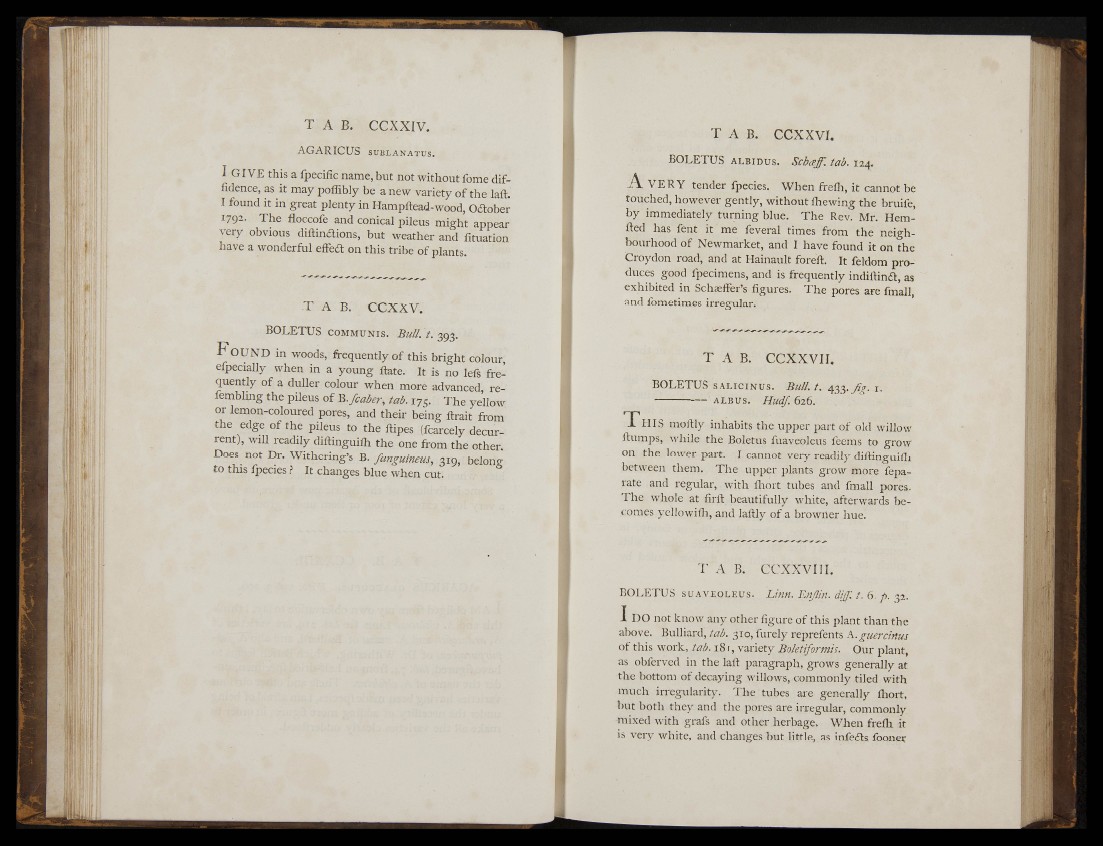
»"'I H
I I
T A B . CCXXIV.
AGARICUS SUBLANATUS.
I GIVE this a fpecific name, but not without fome diffidence,
as it may poffiWy be a new variety of the laft.
I found it in great plenty in Hampilead-wood, October
1792- The floccofe and conical pileus might appear
very obvious diftindlions, but weather and fituation
have a wonderful eiFed on this tribe of plants.
i
I I
T A B. CCXXV.
BOLETUS COMMUNIS. Bull. t. xax
T?
r OUND in woods, frequently of this bright colour
efpecially when in a young itate. It is no lefs frequently
of a duller colour when more advanced refemblmg
the pileus of ^.fcaber, tab. 175. The yellow
or lemon-coloured pores, and their being ilrait from
the edge of the pileus to the ñipes (fcarcely decurrent),
will readily diñinguiíh the one from the other
Does not Dr. Withering's B. fanguineus, 319, belong
to this fpecies ? It changes blue when cut.
T A B. CCXXVJ.
BOLETUS ALBiDus. Schcpff, tab. 124.
A VERY tender fpecies. When freili, it cannot be
touched, however gently, without Ihewing the bruife,
by immediately turning blue. The Rev. Mr. Hemfted
has fent it me feveral times from the neighbourhood
of Newmarket, and I have found it on the
Croydon road, and at Hainault foreft. It feldom produces
good fpecimens, and is frequently indiftina, as
exhibited in SchasfFer's figures. The pores are fmall,
and fometiraes irregular.
T A B . CCXXVII.
BOLETUS sALiciNus. Bull. t. 433../?^. i.
ALBUS. Hudf. 626.
J. HIS moftly inhabits the upper part of old willow
ilumps, while the Boletus fuaveoleus feems to grow
on the lower part. I cannot very readily diftinguiili
between them. The upper plants grow more feparate
and regular, with iliort tubes and fmall pores.
The whole at firft beautifully white, afterwards becomes
yellowifli, and laftly of a browner hue.
T A B. CCXXVIil.
BOI.ETUS SUAVEOLEUS. Linn. Enjlin. dijj: t. 6. p. 32.
I DO not know any other figure of this plant than the
above. Bulliard, tab. 310, furely reprefents A.guercinus
of this work, tab. 18 r, variety Boletiformis. Our plant,
as obferved in the laft paragraph, grows generally at
the bottom of decaying willows, commonly tiled with
much irregularity. The tubes are generally iliort,
but both they and the pores are irregular, commonly
mixed with grafs and other herbage. When frefli it
is very white, and changes but little, as infedls foonev
SI! I ' i
I .